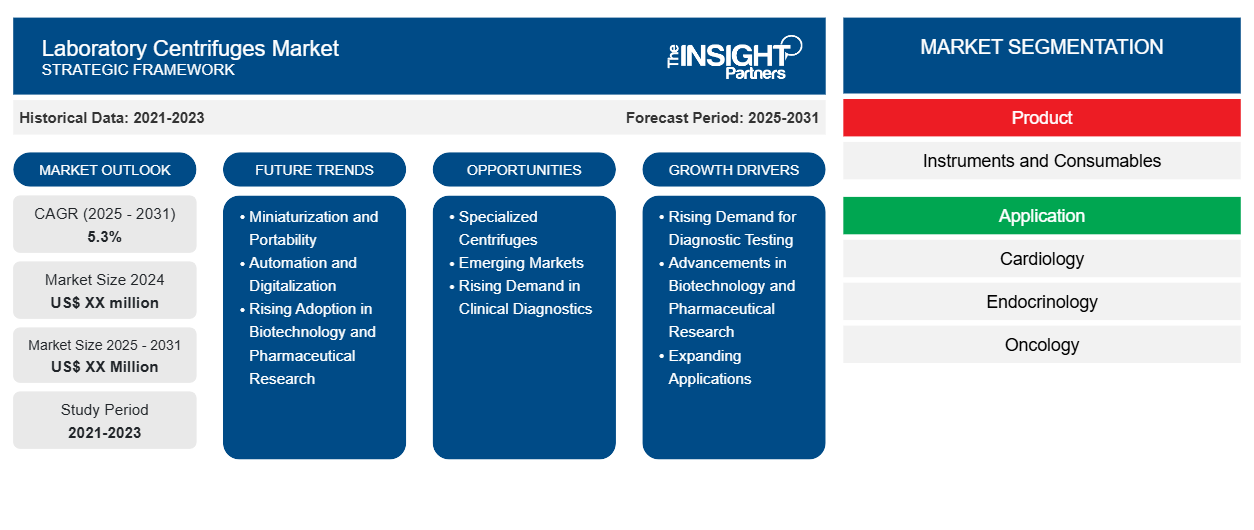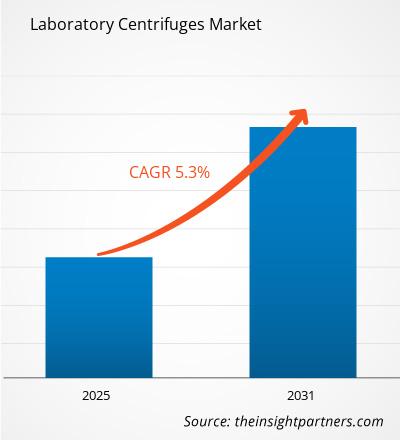The Laboratory Centrifuges Market is expected to register a CAGR of 5.3% from 2025 to 2031, with a market size expanding from US$ XX million in 2024 to US$ XX Million by 2031.
The report is divided into three sections: Product (Instruments and Consumables), Application (Cardiology, Endocrinology, Oncology, Therapeutic Drug Development & Monitoring, Infectious Disease Testing, Drugs Of Abuse Testing) and End User (Hospitals And Clinics, Diagnostic Laboratories, Research Labs & Institutes, Biopharmaceutical & Biotechnology Companies). The global analysis is broken down at the regional level and major countries. The market evaluation is presented in US$ for the above segmental analysis.
Purpose of the Report
The report Laboratory Centrifuges Market by The Insight Partners aims to describe the present landscape and future growth, top driving factors, challenges, and opportunities. This will provide insights to various business stakeholders, such as:
- Technology Providers/Manufacturers: To understand the evolving market dynamics and know the potential growth opportunities, enabling them to make informed strategic decisions.
- Investors: To conduct a comprehensive trend analysis regarding the market growth rate, market financial projections, and opportunities that exist across the value chain.
- Regulatory bodies: To regulate policies and police activities in the market with the aim of minimizing abuse, preserving investor trust and confidence, and upholding the integrity and stability of the market.
Laboratory Centrifuges Market Segmentation
Product
- Instruments and Consumables
Application
- Cardiology
- Endocrinology
- Oncology
- Therapeutic Drug Development & Monitoring
- Infectious Disease Testing
- Drugs Of Abuse Testing
End User
- Hospitals And Clinics
- Diagnostic Laboratories
- Research Labs & Institutes
- Biopharmaceutical & Biotechnology Companies
Geography
- North America
- Europe
- Asia-Pacific
- South and Central America
- Middle East and Africa
Customize This Report To Suit Your Requirement
You will get customization on any report - free of charge - including parts of this report, or country-level analysis, Excel Data pack, as well as avail great offers and discounts for start-ups & universities
Laboratory Centrifuges Market: Strategic Insights

- Get Top Key Market Trends of this report.This FREE sample will include data analysis, ranging from market trends to estimates and forecasts.
Laboratory Centrifuges Market Growth Drivers
- Rising Demand for Diagnostic Testing: Increased focus on early disease detection and personalized medicine drives the need for centrifuges.
- Advancements in Biotechnology and Pharmaceutical Research: Growing research activities in these fields require efficient and reliable centrifugation techniques.
- Expanding Applications: Expanding applications in clinical diagnostics, research, and biotechnology are driving the growth of the laboratory centrifuges market.
Laboratory Centrifuges Market Future Trends
- Miniaturization and Portability: Compact and portable centrifuges offer flexibility and convenience for point-of-care testing.
- Automation and Digitalization: Automated centrifuges with advanced features enhance efficiency and accuracy in laboratories.
- Rising Adoption in Biotechnology and Pharmaceutical Research: Increased use of laboratory centrifuges in biotech and pharmaceutical industries for research and development is a key market trend.
Laboratory Centrifuges Market Opportunities
- Specialized Centrifuges: Centrifuges designed for specific applications, such as microplate centrifuges and ultracentrifuges, offer niche market opportunities.
- Emerging Markets: Developing countries with growing healthcare infrastructure present significant growth potential for laboratory centrifuges.
- Rising Demand in Clinical Diagnostics: The growing need for efficient diagnostic testing presents a significant opportunity for laboratory centrifuges in clinical applications.
Laboratory Centrifuges Market Regional Insights
The regional trends and factors influencing the Laboratory Centrifuges Market throughout the forecast period have been thoroughly explained by the analysts at Insight Partners. This section also discusses Laboratory Centrifuges Market segments and geography across North America, Europe, Asia Pacific, Middle East and Africa, and South and Central America.

- Get the Regional Specific Data for Laboratory Centrifuges Market
Laboratory Centrifuges Market Report Scope
| Report Attribute | Details |
|---|---|
| Market size in 2024 | US$ XX million |
| Market Size by 2031 | US$ XX Million |
| Global CAGR (2025 - 2031) | 5.3% |
| Historical Data | 2021-2023 |
| Forecast period | 2025-2031 |
| Segments Covered |
By Product
|
| Regions and Countries Covered | North America
|
| Market leaders and key company profiles |
Laboratory Centrifuges Market Players Density: Understanding Its Impact on Business Dynamics
The Laboratory Centrifuges Market market is growing rapidly, driven by increasing end-user demand due to factors such as evolving consumer preferences, technological advancements, and greater awareness of the product's benefits. As demand rises, businesses are expanding their offerings, innovating to meet consumer needs, and capitalizing on emerging trends, which further fuels market growth.
Market players density refers to the distribution of firms or companies operating within a particular market or industry. It indicates how many competitors (market players) are present in a given market space relative to its size or total market value.
Major Companies operating in the Laboratory Centrifuges Market are:
- BD
- Danaher Corporation
- Agilent Technologies, Inc.
- Koki Holdings Co., Ltd.
- QIAGEN
Disclaimer: The companies listed above are not ranked in any particular order.

- Get the Laboratory Centrifuges Market top key players overview
Key Selling Points
- Comprehensive Coverage: The report comprehensively covers the analysis of products, services, types, and end users of the Laboratory Centrifuges Market, providing a holistic landscape.
- Expert Analysis: The report is compiled based on the in-depth understanding of industry experts and analysts.
- Up-to-date Information: The report assures business relevance due to its coverage of recent information and data trends.
- Customization Options: This report can be customized to cater to specific client requirements and suit the business strategies aptly.
The research report on the Laboratory Centrifuges Market can, therefore, help spearhead the trail of decoding and understanding the industry scenario and growth prospects. Although there can be a few valid concerns, the overall benefits of this report tend to outweigh the disadvantages.
- Historical Analysis (2 Years), Base Year, Forecast (7 Years) with CAGR
- PEST and SWOT Analysis
- Market Size Value / Volume - Global, Regional, Country
- Industry and Competitive Landscape
- Excel Dataset



Report Coverage
Revenue forecast, Company Analysis, Industry landscape, Growth factors, and Trends

Segment Covered
This text is related
to segments covered.

Regional Scope
North America, Europe, Asia Pacific, Middle East & Africa, South & Central America

Country Scope
This text is related
to country scope.
Frequently Asked Questions
Some of the customization options available based on request are additional 3–5 company profiles and country-specific analysis of 3–5 countries of your choice. Customizations are to be requested/discussed before making final order confirmation, as our team would review the same and check the feasibility.
The report can be delivered in PDF/PPT format; we can also share excel dataset based on the request.
The leading players of this market are: BD, Danaher Corporation, Agilent Technologies Inc, Koki Holdings Co Ltd, QIAGEN, Bio Rad Laboratories Inc, Thermo Fisher Scientific Inc, Sigma Laborzentrifugen GmbH, Eppendorf AG
The future trends of the Laboratory Centrifuges Market are: Miniaturization and Portability and Automation and Digitalization
Laboratory Centrifuges Market is expected to grow at a CAGR of 5.3% between 2023-2031
The driving factors impacting the Laboratory Centrifuges Market are: Rising Demand for Diagnostic Testing and Advancements in Biotechnology and Pharmaceutical Research
Trends and growth analysis reports related to Life Sciences : READ MORE..
1. BD
2. Danaher Corporation
3. Agilent Technologies, Inc.
4. Koki Holdings Co., Ltd.
5. QIAGEN
6. Bio-Rad Laboratories, Inc.
7. Thermo Fisher Scientific Inc.
8. Sigma Laborzentrifugen GmbH
9. Eppendorf AG
10. Andreas Hettich GmbH & Co.KG

 Get Free Sample For
Get Free Sample For